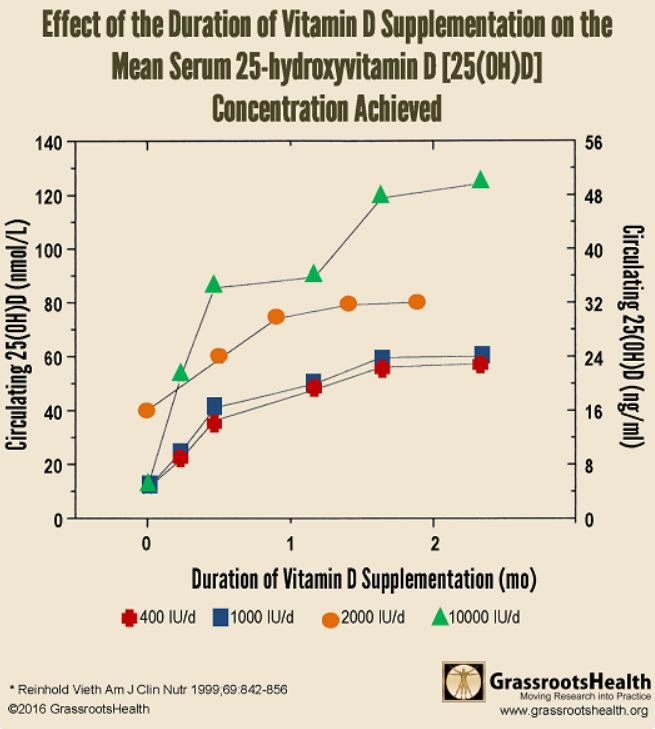Swine flu not prevented by 2,000 IU of vitamin D daily (the upper limit at the time) – RCT 2014
Effects of vitamin D supplements on influenza A illness during the 2009 H1N1 pandemic: a randomized controlled trial
Food Funct., 2014,5, 2365-2370 https://doi.org/10.1039/C4FO00371C
Mitsuyoshi Urashima,*ab Hidetoshi Mezawa,ab Miki Noyaa and Carlos A. Camargo, Jr.c
 * Guess of % > 30 ng in this study
*
* Guess of % > 30 ng in this study
*  * Half the risk of Influenza -A in infants taking 1200 IU of vitamin D for 4 months – RCT Jan 2018
* Overview Influenza and vitamin D
* Vitamin D probably can both prevent Influenza and augment vaccine effectiveness – Aug 2018
* Influenza prevented by 40 ng levels or treated with vitamin D hammer (50,000 IU) – June 2015
* 7X less risk of influenza if Vitamin D levels higher than 30 ng – Oct 2017
* Number of people to treat to prevent 1 case of flu: Vitamin D 4, Vaccination 40 – Feb 2017 Mercola
* FLU FAQ
* Reduce probability of getting the Flu
* Overview Colds and flu and Vitamin D
Flu has the following
{include}
---
63 studies reference this staudy as of Feb 2021
* Half the risk of Influenza -A in infants taking 1200 IU of vitamin D for 4 months – RCT Jan 2018
* Overview Influenza and vitamin D
* Vitamin D probably can both prevent Influenza and augment vaccine effectiveness – Aug 2018
* Influenza prevented by 40 ng levels or treated with vitamin D hammer (50,000 IU) – June 2015
* 7X less risk of influenza if Vitamin D levels higher than 30 ng – Oct 2017
* Number of people to treat to prevent 1 case of flu: Vitamin D 4, Vaccination 40 – Feb 2017 Mercola
* FLU FAQ
* Reduce probability of getting the Flu
* Overview Colds and flu and Vitamin D
Flu has the following
{include}
---
63 studies reference this staudy as of Feb 2021
📄 Download the PDF from sci-hub via VitaminDWiki
In a prior randomized trial, we found that the incidence of influenza A was less in the vitamin D3 group than among those on placebo, but the total incidence of either influenza A or B did not differ between groups. In this trial, the incidence of influenza A or B was less in the vitamin D3 group than in the placebo group only during the first half of the study. To elucidate whether vitamin D3 has preventive actions against influenza A, we conducted another trial during the 2009 pandemic of the H1N1 subtype of influenza A. Students (n = 247) of a Japanese high school were randomly assigned to receive vitamin D3 supplements (n = 148; 2000 IU per day) or a placebo (n = 99) in a double-blind study for 2 months. The primary outcome was incidence of influenza A diagnosed by a rapid influenza diagnostic test by medical doctors. Influenza A was equally likely in the vitamin D3 group (20/148: 13.5%) compared with the placebo group (12/99: 12.1%). By post hoc analysis, influenza A occurred significantly less in the vitamin D3 group (2/148: 1.4%) compared with the placebo group (8/99: 8.1%) (risk ratio, 0.17; 95% confidence interval, 0.04 to 0.77; P = 0.009) in the first month. However, during the second month, the vitamin D3 group experienced more events and effectively caught up with the placebo group. Vitamin D3 supplementation did not lower the overall incidence of influenza A during the 2009 H1N1 pandemic. A post hoc analysis suggests that the initial benefit during the first month of treatment was lost during the second month.
